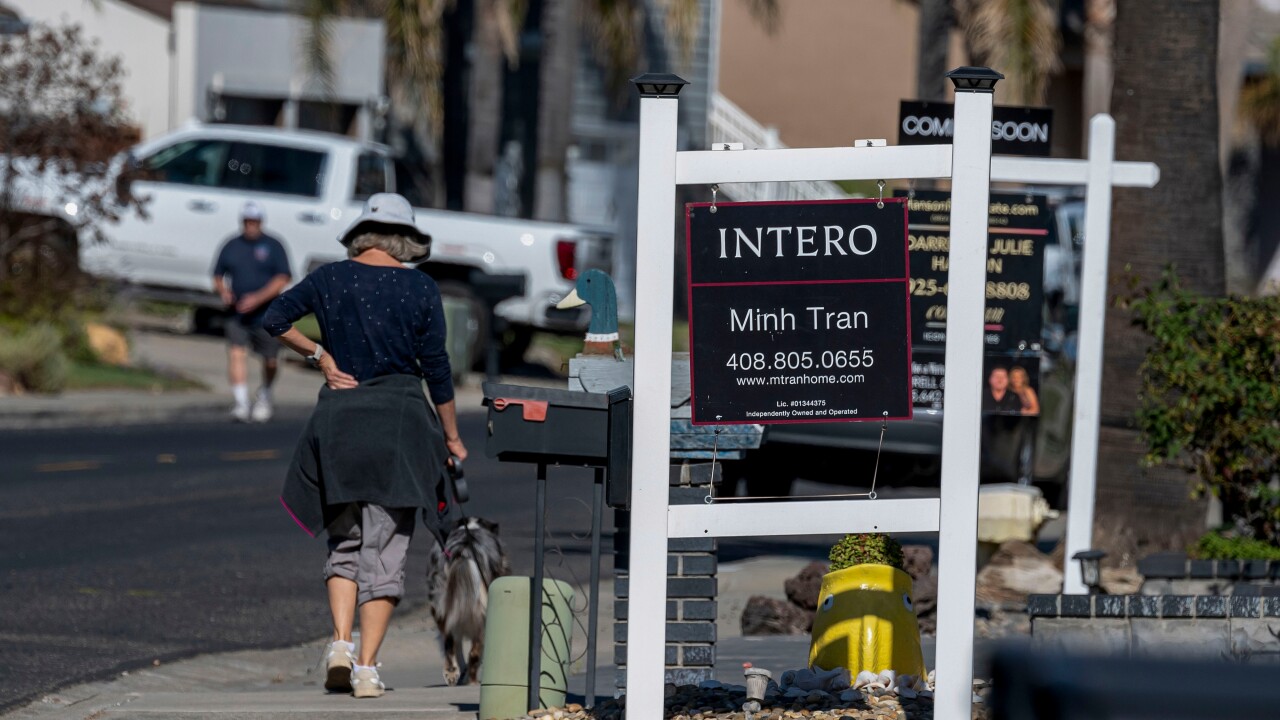Piggyback mortgages all but disappeared following the housing bust but they appear to be staging a comeback as lenders continue to gain confidence in the housing recovery.
With home prices continuing to rise, mortgage brokers say lenders are showing more willingness to fund the loans, which home buyers typically take out in order to avoid paying private mortgage insurance.
Brian D. Minkow, a senior vice president at Prospect Mortgage, a Sherman Oaks, Calif., independent mortgage broker, says piggyback loans are gaining traction in certain high-cost areas like Boston, Los Angeles and New York, where the home price exceeds the maximum loan limits set by Fannie Mae and Freddie Mac.
Borrowers also want the lowest monthly mortgage payment possible, and taking out a second mortgage is still less expensive than paying private mortgage insurance or getting a jumbo loan.
"Getting a super jumbo loan is not easy and this is helping bridge the gap," says Minkow. "These are full-doc, high-FICO-score loans and in a market today where home values are rising, the risk is minimal now."
The demand for so-called piggyback home equity lines of credit, which are open-ended, is coming at a good time for lenders. The refinancing boom that has been driving bank profits of late is widely expected to end this year and income from piggyback loans can help cushion the blow.
Banks also may be eager to promote the loans now before certain regulations that limit the amount of points and fees lenders can charge take effect next year, industry observers say.
TCF Financial Corp., the $19.1-billion-asset bank in Wayzata, Minn., has been marketing piggyback HELOCs for the past few years and is now expanding into a number of new states through a network of approved mortgage brokers.
The bank requires a 700 credit score (720 in California) and a 45% debt-to-income ratio. It even has a mortgage calculator that allows brokers to compare the cost of a jumbo mortgage or a mortgage with mortgage insurance to a first mortgage with a TCF home equity line of credit.
"It's a program we're happy with…and we're going to continue moving forward with it as long as we can," says Jason Korstange, a TCF senior vice president.
"It indicates at least a sense of pragmatism if not optimism that banks are getting back into certain product lines," says Jacobs. "For a long time, banks have had no interest in this product because of the uncertainty of home values and the borrower stability. And it's a leading indicator that if all goes well they may expand it to their third-party originator channels."
Still, some mortgage insurers and consumer advocates question whether the return of piggyback HELOCs, especially those sold through brokers, is a good thing. Piggyback mortgages fell out of fashion primarily when housing prices starting dropping and wiping out the equity of many borrowers. Data shows they had much higher default and foreclosure rates, partly because of looser underwriting standards and minimal downpayment requirements, and generally performed much worse during the recent downturn than loans originated with private mortgage insurance.
"The question is, what is the strength of the underwriting and are they layering on risks?" says S.A. Ibrahim, the chief executive at Radian Group, the Philadelphia mortgage insurer. "There is nothing inherently wrong with selling through brokers, but if you are lending to a far-flung geography and using third parties, it means multiple red flags because of the multiple risks."
Lenders, though, appear to be proceeding with more caution than they did in the past. Specifically, those offering the loans are typically requiring a 10% downpayment from borrowers. That wasn't the case back in the bubble days, when a borrower would often receive a government-backed loan for 80% of the home’s value and take out a piggyback home equity line of credit for the remaining 20%.
Piggyback HELOCs are not being originated in huge numbers largely because there is no secondary market for banks to securitize and sell the loans. Though TCF underwrites the loans, it does not typically keep them on its balance sheet but rather sells them as whole loans to investors, Korstange says. In the fourth quarter, TCF sold $25 million to $30 million of the HELOCs and has indicated it plans to sell more. The company has $6.5 billion of home equity lines of credit in its portfolio, though Korstange would not say how many are piggyback HELOCs.
Asked about criticism of the loans in the past, Korstange said, "If it starts to be an issue, we'll turn back."
The Consumer Financial Protection Bureau acknowledged in its recent qualified mortgage rule, by writing into the rule that lenders consider verifying HELOCs and other types of "simultaneous loans" for the purpose of complying with the "ability-to-repay" provision. The CFPB did exempt the loans from rule governing points and fees that a lender can charge a borrower, but said it will monitor that exemption.
HELOCs, though, are subject to Home Ownership and Equity Protection Act, or HOEPA, rules, that limit points and fees to 5% of the loan amount that will take effect in January 2014.
Andrew Pizor, an attorney at the National Consumer Law Center, says the biggest problem with HELOCs is that most of the time borrowers draw the entire amount at closing and it will take years before they actually can build enough equity to access the line of credit. Also, borrowers typically are given an annual percentage rate for the HELOC that includes only interest, not closing costs, making the loans appear cheaper than they are, especially when compared with traditional closed-end mortgages that include closing costs.
"It's spurious open-end credit," Pizor says. "If it's a fully drawn HELOC, the borrower is probably paying more for it, so it's deceptive and that's one big reason why lenders want to push HELOCs over closed-end second liens. There's a big difference in the borrower's understanding of what they're getting and paying for."





